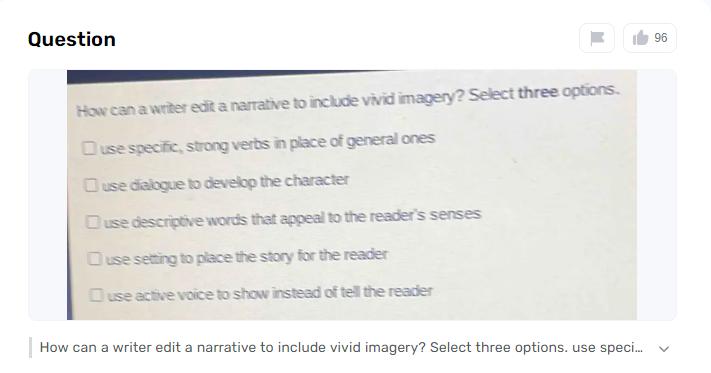By transporting the reader to a different world, a captivating story thrives. This is made possible in large part thanks to the art of vivid imagery, or painting a picture with words. Yet, how might essayists create depictions that not only vividly illustrate scenes but also resonate deeply with their audience? How can they ensure that their descriptions evoke emotions?
This article investigates three critical methodologies for injecting your account with powerful symbolism and we will explore how can a writer edit a narrative to include vivid imagery? select three options. By implementing these procedures, you can transform your story from a basic record to a multi-sensory experience, having an enduring impact on your readers.
Editing a Narrative for Including Vivid Imagery
Altering a story and consolidating clear symbolism really can be achieved in three ways:
Use powerful, Specific Verbs Rather than General Ones
Verbs propel the action and give the reader a clearer picture, making them the heart of any story. Pick explicit, striking options that inspire a more grounded mental picture instead of depending on conventional action words like walk or run. For instance, supplant “strolled” with walked, jogged, or walked, each conveying particular implications and symbolism.
These particular verbs not only describe the action but also add subtleties to the scene that stimulate the imagination of the reader.
Utilize Expressive Words That Enticement for the Peruser’s Senses
Narratives come to life when descriptive language appeals to a variety of senses. Integrate clear modifiers and intensifiers that inspire tactile encounters, like sight, sound, smell, taste, and contact. The spacious room was bathed in soft, golden sunlight, casting long shadows across the polished wooden floor, for instance, is a better way to describe a room than to use the word “large.”
Such portrayals make visual symbolism as well as bring out feelings and inundate perusers all the more profoundly into the story’s current circumstance.
Use Setting to Ground the Story for the Reader
The setting enhances the reader’s comprehension and experience by acting as a backdrop that places the story in a specific time and place. Setting descriptions can be used effectively to set the mood, atmosphere, and context. Portray the actual climate exhaustively, including topographical highlights, weather patterns, and social components.
For instance, putting the reader in a bustling market with vendors selling their wares and the lingering scent of exotic spices instantly transports them there. You provide readers with a sensory-rich experience that strengthens their connection to the narrative by vividly describing the setting.
Steps to Use Gauth for Literature Queries
Using Gauth for literature queries can help you better understand and analyze literary works. Gauth can assist you in comprehending intricate literary elements and themes, regardless of whether you are studying poetry, novels, or plays. A comprehensive guide to using Gauth for literature queries is provided below:
Step 1. Open Gauth
To begin, open either the Gauth website or the Gauth app on your device.
Step 2. Put Your Literature Query in the Search Box
Type or paste it into the search box. Questions about themes, symbolism, character analysis, or any other aspect of the text you’re studying could fall under this category. Gauth’s man-made intelligence calculations can handle different types of scholarly inquiries, including entries from texts or explicit inquiries concerning abstract gadgets.

Step 3. Wait for Processing
To receive the answer, submit your query. Gauth will handle the data and furnish you with a nitty gritty arrangement. Step-by-step explanations of themes, character motivations, and literary devices may all be part of the solution.
Step 4. Examine the Solution
Take the time to examine Gauth’s solution. Pay attention to the provided analysis and explanations because they can help you better comprehend the text. To further strengthen your comprehension, compare the solution to your own interpretations and insights.
Final Thoughts
It takes more than just adding descriptive words to a narrative to include vivid imagery; it also requires careful editing and attention to detail. A writer can make their narrative vivid and engaging by employing strong, specific verbs, appealing to the reader’s senses with descriptive language, and effectively utilizing the setting. These procedures upgrade the peruser’s insight as well as lift the general nature of the composition, making the account really convincing and significant.









